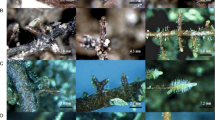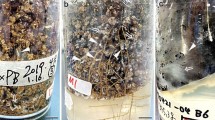Abstract
A study was undertaken to determine the ability to form ectomycorrhizae with Pinus pinaster Ait. in pure culture syntheses of 98 isolates of putative mycorrhizal fungi, mainly collected in northern Spain. A total of 35 species in 16 genera — Amanita, Cenococcum, Collybia, Cortinarius, Hebeloma, Laccaria, Lactarius, Lyophyllum, Melanogaster, Paxillus, Pisolithus, Rhizopogon, Scleroderma, Suillus, Thelephora and Xerocomus — formed ectomycorrhizae. Many of these fungal species were not previously reported as symbiotic with Pinus pinaster. Results obtained increase the range of potential fungal candidates for inoculation of nursery seedlings.
Similar content being viewed by others
References
Alvarez IF, Parladé J, Trappe JM, Castellano MA (1993) Hypogeous mycorrhizal fungi of Spain. Mycotaxon 47:201–217
Anonymous (1989) Anuario de estadística agraria. Ministerio de Agricultura Pesca y Alimentatión Madrid
Azevedo N (1982) Ectomicorrizas del Pinus pinaster Sol. ex Ait. Bol Estación Cental Ecol (ICONA) 11:37–42
Barsali E (1922) Contribuzione allo studio del rapporti delle micorize ectotrofiche di alcune essenze arboree. Atti Soc Toscana Sci Nat Proc Verb 31:16–20
Branzanti B, Zambonelli A (1987) Effetti della micorrizazione sullo sviluppo di semenzali di Pinus pinaster. Microbiol Ital 2:53–57
Ceruti A (1965) La tartuficoltura in Italia. Ann Accad Agr Torino 107:1–12
Costantini J (1923) La vie mystérieuse des champignons. Mise au point du problème des mycorhizes de conifers. Rev Sci 61:733–737
Danielson RM, Visser S, Parkinson D (1984) Production of ectomycorrhizae on container-grown jack pine seedlings. Can J For Res 14:33–36
David A, Faye M, Rancillac M (1983) Influence of auxin and mycorrhizal fungi on the in vitro formation and growth of Pinus pinaster roots. Plant Soil 71:501–505
Deacon JW, Donaldson SJ, Last FT (1983) Sequences and interactions of mycorrhizal fungi on birch. Plant Soil 71:257–262
Debaud JC, Gay G (1987) In vitro fruiting under controlled conditions of the ectomycorrhizal fungus Hebeloma cylindrosporum associated with Pinus pinaster. New Phytol 105:429–435
Dexheimer J, Aubert-Dufresne M-P, Gèrard J, Le Tacon F, Mousain D (1986) Étude de la localisation ultrastructurale des activités phosphatasiques acides dans deux types d'ectomycorhizes: Pinus nigra nigricans/Hebeloma crustuliniforme et Pinus pinaster/Pisolithus tinctorius. Bull Soc Bot Fr 133:343–352
Dighton J, Mason PA (1985) Mycorrhizal dynamics during forest tree development. In: Moore D, Casselton LA, Woods DA, Frankland JC (eds) Development biology of higher fungi. (British Mycology Society Symposium 10) Cambridge University Press, Cambridge, pp 117–139
Doumas P, Berjaud C, Calléja M, Coupé M, Espiau C, d'Auzac J (1986) Phosphatases exatracellulaires et nutrition phosphatée chez les champignons ectomycorhiziens et les plantes hôtes. Physiol Veg 24:173–184
Fernandez de Ana FJ, Rodríguez A, Rodríguez-Fernández RJ (1989) A influencia dos tratamentos silvicolas na micetacion dos macromicetos. III Congreso Luso-Galaico de Macromicoloxía, Vila Real, Portugal, pp 1–20
Ferreira dos Santos N (1941) Elementos para o estudio das micorrizas ectendotróficas do Pinus pinaster Sol. Publ Serv Florestais Agric Portugal 8:65–95
Fleming LV, Deacon JW, Last FT (1986) Ectomycorrhizal succession in a Scottish birch wood. In: Gianinazzi-Pearson V, Gianinazzi S (eds) Mycorrhizae: physiology and genetics. INRA, Paris, pp 259–264
Gil L, Gordo J, Alia R, Catalán G, Pardos JA (1990) Pinus pinaster Aiton en el paisaje vegetal de la Peninsula Ibérica. Ecología 1:469–495
Godbout C, Fortin JA (1983) Morphological features of synthesized ectomycorrhizae of Alnus crispa and A. rugosa. New Phytol 94:249–262
Guinberteau J, Ducamp M, Poipou N, Mamoun M, Olivier JM (1990) Ecology of various competitors from an experimental plot of Pinus pinaster inoculated with Suillus granulatus and Lactarius deliciosus. Agric Ecosyst Environ 28:161–165
Heim R (1957) Les champignons d'Europe, vol I. Boubée, Paris
Heim R, Font Quer P, Codina J (1934) Fungi Iberici. Observations sur la Flore Mycologique Catalane. Treb Mus Cienc Nat Barcelona, Ser Bot 15:1–146
Kropp BR (1982) Fungi from decayed wood as mycorrhizal simbionts of western hemlock. Can J For Res 12:36–39
Kropp BR, Trappe JM (1982) Ectomycorrhizal fungi of Tsuga heterophylla. Mycologia 74:479–488
Malajczuk N, Molina R, Trappe JM (1982) Ectomycorrhiza formation in Eucalyptus. I. Pure culture synthesis, host specificity and mycorrhizal compatibility with Pinus radiata. New Phytol 91:467–482
Marx DH (1969) The influence of ectotrophic mycorrhizal fungi on the resistance of pine roots to pathogenic infections. I. Antagonism of mycorrhizal fungi to root pathogenic fungi and soil bacteria. Phytopathology 59:153–163
Marx DH (1977) Tree host range and world distribution of the ectomycorrhizal fungus Pisolithus tinctorius. Can J Microbiol 23:217–223
Marx DH (1980) Ectomycorrhizal fungus inoculations: a tool for improving forestation practices. In: Mikola P (ed) Tropical mycorrhiza research. Oxford University Press, New York, pp 13–71
Marx DH (1991) The practical significance of ectomycorrhizae in forest establishment. In: Ecophysiology of ectomycorrhizae of forest trees. Proceedings of the Marcus Wallenberg Foundation, no 7, Stockholm, Sweden, pp 54–90
Marx DH, Bryan WC (1970) Pure culture synthesis of ectomycorrhizae by Thelephora terrestris and Pisolithus tinctorius on different conifer hosts. Can J Bot 48:639–643
Mason PA, Last FT, Pelham J, Ingleby K (1982) Ecology of some fungi associated with an ageing stand of birches (Betula pendula and B. pubescens). For Ecol Manag 4:19–39
Mason PA, Wilson J, Last FT, Walker C (1983) The concept of succession in relation with the spread of sheathing mycorrhizal fungi on inoculated tree seedlings growing in unsterile soil. Plant Soil 71:247–256
Molina R (1979) Pure culture synthesis and host specificity of red alder mycorrhizae. Can J Bot 57:1223–1228
Molina R, Palmer JG (1982) Isolation, maintenance, and pure culture manipulation of ectomycorrhizal fungi. In: Schenck NC (ed) Methods and principles of mycorrhizal research. American Phytopathological Society, St Paul, Minn, pp 115–129
Molina R, Trappe JM (1982) Patterns of ectomycorrhizal host specificity and potential among Pacific Northwest conifers and fungi. For Sci 28:423–457
Mousain D (1971) Essai d'analyse de la symbiose ectomycorhizienne chez le Pin maritime. PhD thesis, University of Science and Technology, Montpellier
Mousain D, Lamond M (1978) Influence de la concentration en phosphate (H2PO −4 ) de la solution nutritive sur la mycorhization du Pinus pinaster par le Pisolithus tinctorius et l'Hebeloma cylindrosporum (élevage sur caisson à aèrosol nutritif). In: Riedacker A, Gagnaire-Michard J (eds) IUFRO C R Symposium: Physiologie des Racines et Symbioses, Nancy, pp 473–475
Mousain D, Delmas J, Poitou N (1977) Influences of the ectomycorrhizae of Hebeloma cylindrosporum and Pisolithus tinctorius on the growth of young cluster pine. Proceedings of the 3rd North American Conference on Mycorrhizae, Athens, Georgia, p 94
Mousain D, Couteaudier Y, Pierson J (1979) Synthèses de mycorhizes du Lactarius deliciosus chez le Pinus pinaster. Ann Phytopathol 11:130
Mousain D, Poitou N, Delmas J (1979) La symbiose mycorhizienne: resultats obtenus avec l' Hebeloma cylindrosporum et le Pisolithus tinctorius, et perspectives d'application agronomique. Mushroom Sci 10:949–956
Nicolas A, Gandullo JM (1967) Ecología de los pinares españoles. I. Pinus pinaster Ait. IFIE, Madrid
Plassard C, Mousain D, Salsac L (1983) Dosage de la chitine sur des ectomycorhizes de pin maritime (Pinus pinaster) à Pisolithus tinctorius: évaluation de la masse mycèlienne et de la mycorhization. Can J Bot 22 61:692–699
Plassard C, Coll A, Mousain D, Salsac L (1988) Estimation quantitative de l'infection ectomycorhizienne du Pin maritime (Pinus pinaster Aiton) en pépinière. Acta Oecol Plant 9:381–391
Poitou N, Mamoun M, Delmas J (1982) Quelques résultats obtenus concernant la mycorhization de plantes-hôtes par les champignons mycorhiziens comestibles. In: Gianinazzi S, Gianinazzi-Pearson V, Trouvelot A (eds) Les mycorhizes: biologie et utilization. (Les Colloques de l'INRA, no 13) INRA, Paris, pp 295–301
Rancillac M (1982) Multiplication vegetative in vitro et synthese mycorhizienne: pin maritime — hebelome, pisolithe. In: Gianinazzi S, Gianinazzi-Pearson V, Trouvelot A (eds) Les micorhizes: biologie et utilization. (Les Colloques de l'INRA, no 13) INRA, Paris, pp 351–357
Rayner MC, Levisohn I (1941) The mycorrhizal habit in relation to forestry. IV. Studies on mycorrhizal response in Pinus and other conifers. Forestry 15:1–36
Ruehle JL, Marx DH, Aborouh M (1981) Development of Pisolithus tinctorius and Thelephora terrestris ectomycorrhizae on seedlings of coniferous trees important to Marocco. Ann Rech For Maroc 21:283–296
Scheromm P, Plassard C, Salsac L (1990) Nitrate nutrition of maritime pine (Pinus pinaster Soland in Ait.) ectomycorrhizal with Hebeloma cylindrosporum Romagn. New Phytol 114:93–98
Scott CW (1962) A summary of information of Pinus pinaster Ait. For Abstr 23
Singer R (1945) Notes on Farlow's Agaricales from Chocorua. Farlowia 2:39–51
Takacs EA (1961) Algunas especies de hongos formadores de micorrizas en árboles forestales en la Argentina. Rev For Argentina 5:80–82
Trappe JM (1962) Fungus associates of ectotrophic mycorrhizae. Bot Rev 28:538–606
Trappe JM (1964) Mycorrhizal hosts and distribution of Cenococcum graniforme. Lloydia 27:100–106
Trappe JM (1969) Studies on Cenococcum graniforme. I. An efficient method for isolation from sclerotia. Can J Bot 47:1389–1390
Trappe JM (1977) Selection of fungi for ectomycorrhizal inoculation in nurseries. Annu Rev Phytopathol 15:203–222
Trofymow JA (1990) A review of outplanting trials with ectomycorrhizal conifer seedlings. Proceedings of the 8th North American Conference on Mycorrhizae, Jackson, Wyoming, p 289
Vidal JM (1991) Contribución al conocimiento de la flora micológica del Baix Emporda y zonas limítrofes (Catalunya). IV. Hongos hipogeos (Zygomicotina, Ascomycotina y Basidiomycotina). Bull Soc Catalana Micol 14–15:143–194
Villeneuve N, Le Tacon F, Bouchard D (1991) Survival of inoculated Laccaria bicolor in competition with native ectomycorrhizal fungi and effects on the growth of outplanted Douglas fir seedlings. Plant Soil 135:95–107
Author information
Authors and Affiliations
Rights and permissions
About this article
Cite this article
Pera, J., Alvarez, I.F. Ectomycorrhizal fungi of Pinus pinaster . Mycorrhiza 5, 193–200 (1995). https://doi.org/10.1007/BF00203337
Issue Date:
DOI: https://doi.org/10.1007/BF00203337




